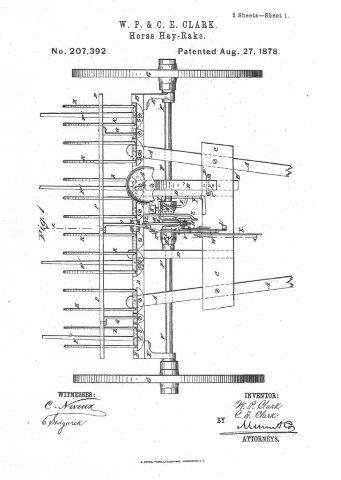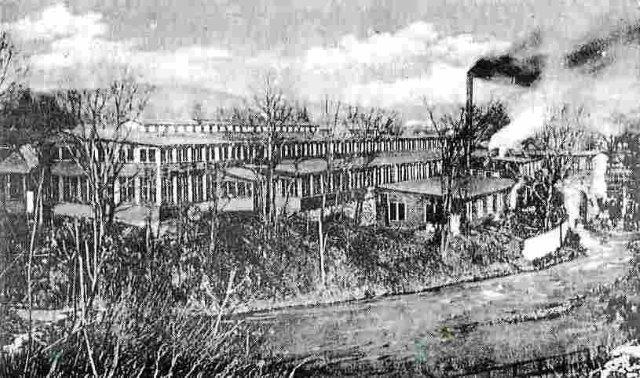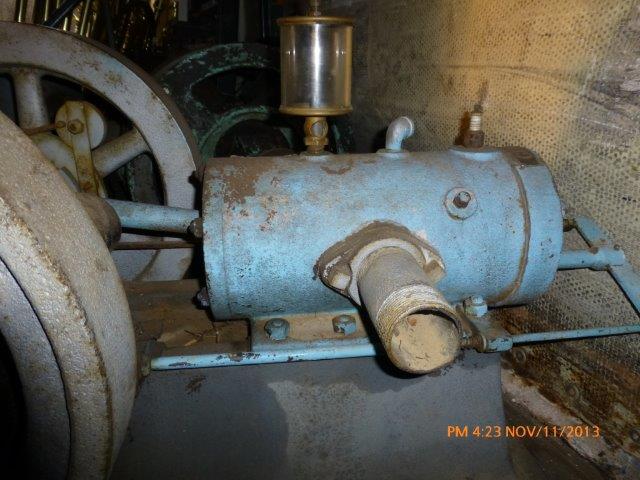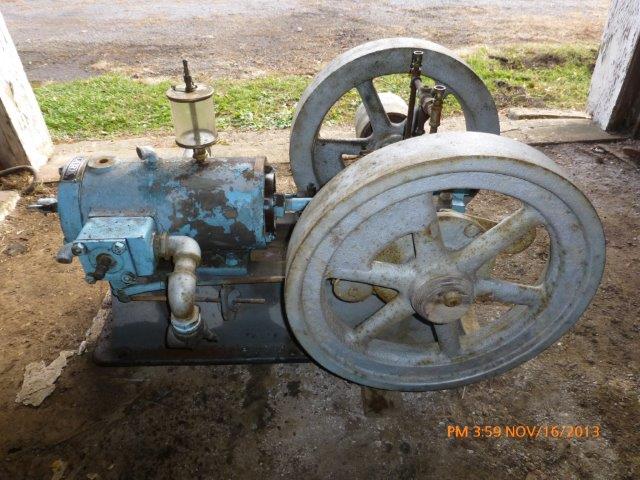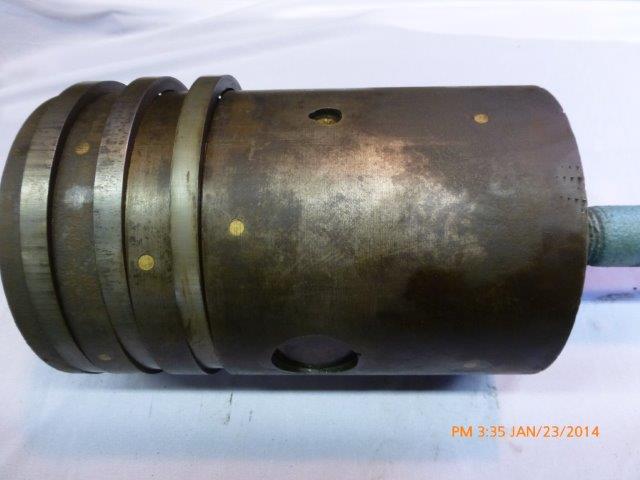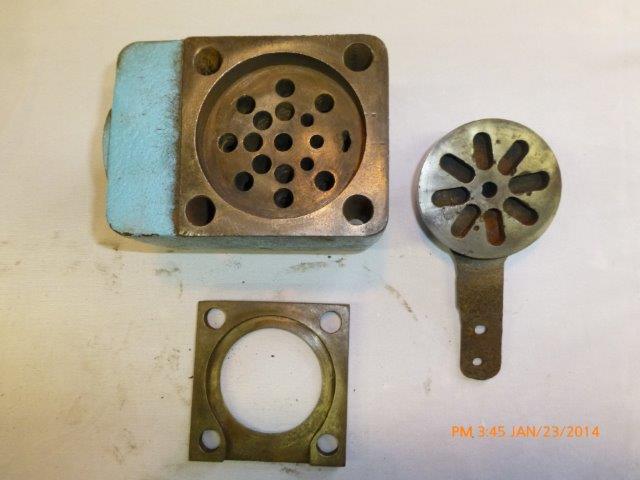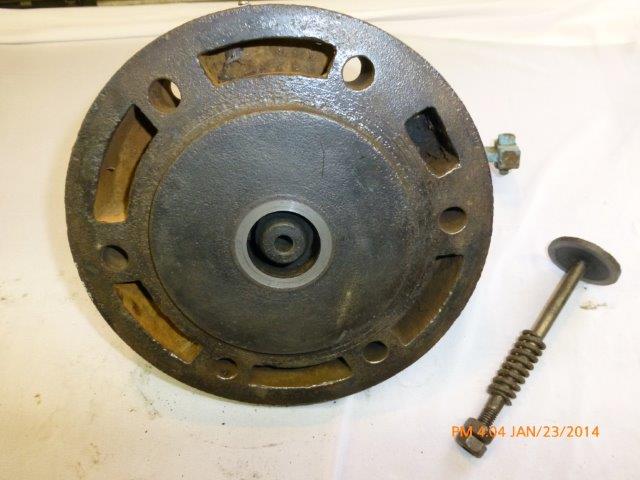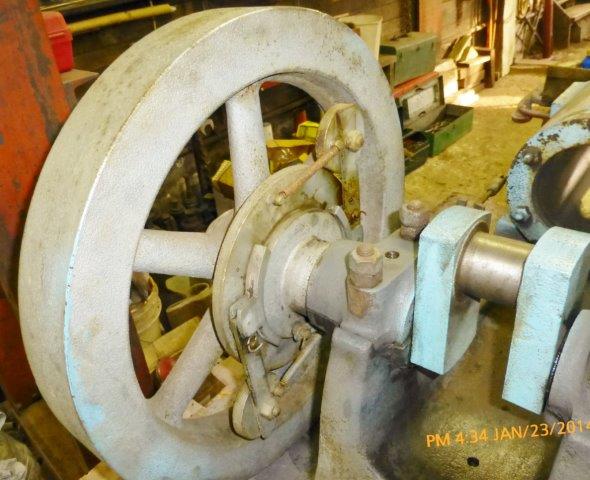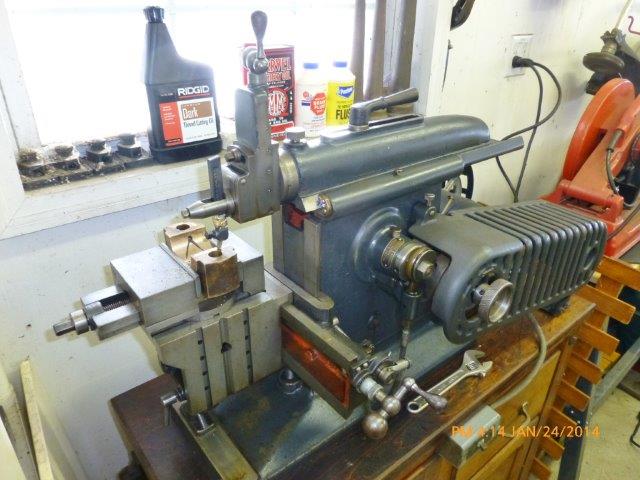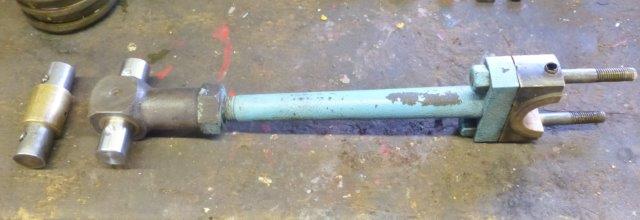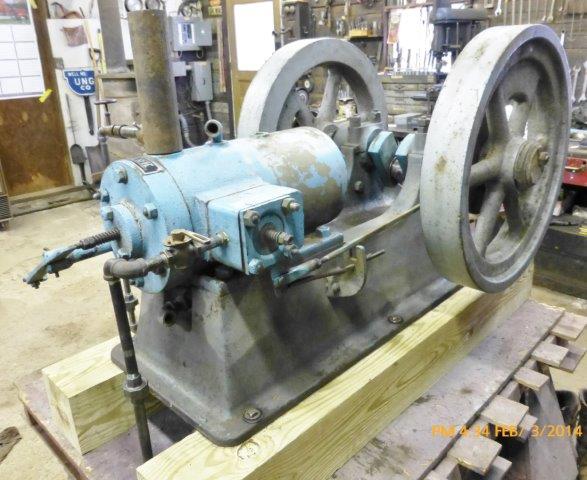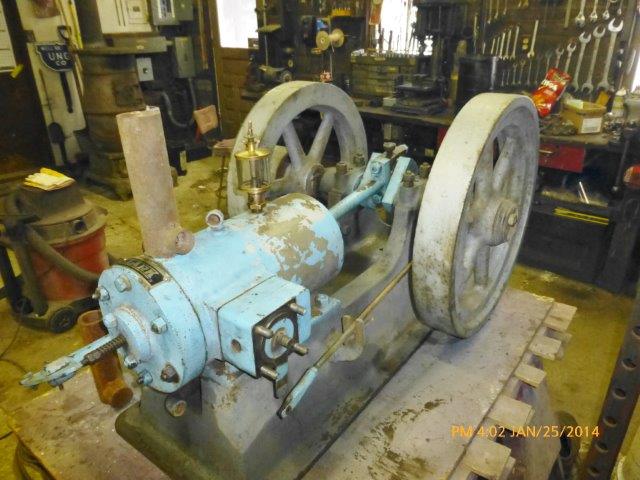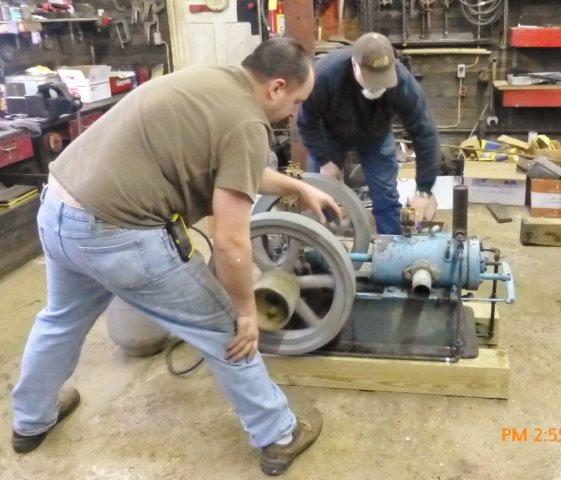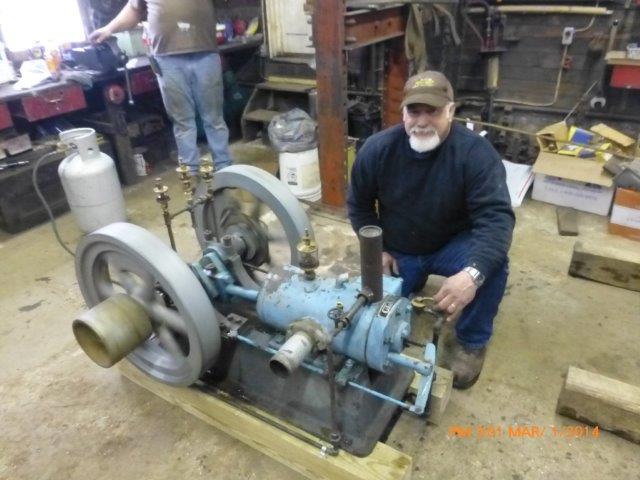|

April 2014
Clark's Story
By
Paul Harvey
This is the story of a little engine named
Clark - his history and his rebirth. At least we are
told that his name is Clark as no one has ever
seen one like him nor has any records of his birth.
Clark was donated to the museum many years ago by the late
Ralph (Sonny) Wilson of Allegany, New York.
Sonny told us the engine was built by Clark Brothers Company of nearby
Belmont, New York, about
1900. Originally purchased by neighbor Vernon Fields, the engine was
used to power a buzz saw to cut firewood for a maple syrup sugar
shack. Later abandoned in a ditch, Sonny found the engine laying west
of Five Mile Road
near Allegany. Clark had a magneto and gasoline
mixer attached, apparently not original, and, using these, Sonny got him
operational for local displays.
In 1976, for the Olean,
New York Bicentennial, Dresser-Rand, Clark
Brothers successor, adopted him. He received a quick paint job of blue
and silver, the new firm's colors, and had attached a modern
Clark name plate. After the event, they returned
Clark to his owner and, several years later, Sonny donated
the engine to Coolspring
Power Museum.
Clark sat proudly on display in the museum's Expo Building for several
years but, with so many other projects, the museum tucked him away in
safe storage, and he lived, forgotten and in seclusion, for many years.
Then, in November 2013, Mr. Wilson's son, Keith, inquired about
Clark and his life at the museum.
Spurred on by the inquiry, we looked at Clark
and, finding him amazingly interesting, we got him out of storage and
into our heated shop to do a winter rebirth. We were pleased to find
that Clark had very pleasant lines and a most
unusual mechanism. The castings were well done but other parts were
very crudely made. There was no name anywhere on the engine, other than
the 1976 name plate, nor any casting numbers. Being unlike anything
else Clark Brothers ever built made us wonder if
Clark could have been a prototype and the only one in
existence? We will probably never know.
Going back in history over 100 years, we find two brothers
from Belmont, New York,
William Pendleton Clark and Charles Ethan Clark, becoming interested in
the manufacturing business. At that time, the
Belmont area had large farms and huge stands of
timber so they concentrated on products needed to manage these
resources. In 1878, the brothers patented a hay rake; see Photo
1. Soon they found a great demand for steam engines and sawmill equipment and rapidly rose to be one of the major makers of these
items in the entire country. Photo 2 depicts their plant
in 1908, the largest in Allegany County,
New York. They built huge band saws and Corliss
style steam engines in the 2,000 hp range.
Soon the vast stands of timber were exhausted and the
sawmill trade declined. But a new industry was now in its infancy and
rapidly increasing; oil and gas production and transportation. So a
new chapter opened for the Clark Brothers. William Clark, always the
promoter, looked into the future of the firm while his brother Charles,
now living in Wellsville, New
York, teamed with William Henry Norton in 1907
to found the firm of Clark and Norton. Charles did not leave the Clark
Brothers Company, but remained as vice president while building a
competing firm in Wellsville.
Mr. Norton was educated at Alfred
University, Alfred,
New York, located in
Allegany County,
and already was engaged in the Norton Oil Company and the McEwin-Norton
Oil Company of Wellsville,
New York. He invented the Norton pumping power
and was an accomplished surveyor. In addition to Clark Brothers, the
new firm of Clark and Norton also prospered and built huge oil and gas
pumping equipment. Only about 20 miles apart, they built a parallel
line of equipment and their plant still stands on West Dyke and South
Main Streets in Wellsville. The demand must have been great to support
both firms in harmony with each other!
The destiny of Clark Brothers Company was changed on the
night of May 11, 1912
when a huge fire consumed the plant, a nearby wagon works, and several
houses. A special train brought a Genesee steam
pumper from Wellsville which saved the entire
village of Belmont
from being consumed by the conflagration. Company president William
Clark was in New York City
on business at the time, but brother Charles, vice president, issued a
statement that Clark Brothers would be continued. He volunteered his
other interest, Clark and Norton, to supply orders until the new plant
could be erected. With the new oil and gas industry centered around
Olean, New York, Clark
Brothers decided to rebuild there. So Belmont
again became a quiet agricultural village and the huge new factory was
erected in Olean. This
plant still builds compressors for the Dresser-Rand Corporation. At
this time, the brothers proceeded on their separate ventures - William
in Olean and Charles in
Wellsville.
Moving ahead 100 years, we now return to Clark's
story. Photo 3 shows Clark as
we found him on November 11,
2013, safely tucked away in a storage trailer at the
museum. It had been years since he saw the light of day! Five days
later, and with the nice weather still holding, Clark
was sitting in the shop awaiting the time he would come to life again.
He would have a warm winter home and life was looking good. See
Photo 4. We began to assess the project and found the engine
to be in remarkably good condition. With a little oil and effort, all
parts moved! It was decided that we would decipher the complicated
intake chest and governor, then proceed with a mechanical restoration
keeping the "as received ambience" that told so much of his history.
Complete disassembly and repair would now be required.
The piston, 5½ inches in diameter, slid out easily
revealing three large rings as shown in Photo 5.
Looking closely at the photo, note the odd brass plugs inserted into
the piston at random intervals and machined smooth to the piston
surface. They do not seem to fill any casting defects and have no
apparent use. Another of Clark's mysteries!
Photo 6 shows the intake chest with the rotary throttle. The
small disc to the right containing slots is slightly rotated by the
governor to either align or close the holes in the chest to regulate the
passage of air and gas. This required some lapping with Clover compound
to secure a good seal again. The small plate holds all together.
Clark has a ported cylinder with a
huge 2½ inch diameter exhaust pipe that was well shown in photo
three. Quite unusual for an engine with a 5½ inch piston bore
and a 6 inch stroke. The gases from the exhaust valve are ported
through the head then on through the cylinder to the big exhaust pipe.
As shown in Photo 7, the exhaust is the smaller black
passage to the right in the head. The five other larger openings are
for the cooling water. The exhaust valve has a flat seat and is quite
small and fragile. It is operated by timing gears, push rod, and
rocker arm, all lightly and crudely constructed.
Most interesting is Clark's unusual
governor illustrated in Photo 8. Within one flywheel
are two expanding weights, similar to other engines, that detect the
speed of the engine and spread apart as the speed increases. The
linkage used in the flyweight arms is unfinished flat steel. But there
all similarity to other engines ceases. The arms are connected to two
cast iron shoes that apply pressure to a large cast iron collar. These
parts are very nicely done. As the engine speed increases, the governor
causes the shoes to press tighter on the rim of the collar, rotating it
a bit. The collar has a lever attached and, by means of a linkage,
moves the rotary throttle plate to admit less gas and air. As the speed
decreases, a spring returns the collar, and hence the rotary throttle,
to admit more gas and air. A very unusual and ingenious system!
The bearings were all disassembled, cleaned and measured for
appropriate fit. The rod brass is very nicely made but showed a bit of
wear. Photo 9 shows one half of the bearing mounted in
the shaper to remove 0.004 of an inch of brass. A perfect fit was
obtained with this done to each half. The piston pin and its brass
bushing were also worn as noted in Photo 10. A friend
made the new parts which worked well.
Parts were finished and assembly was proceeding very well.
Photo 11 shows the intake valve chest with the rotary
throttle. A bit complicated but it appears to work well. Similar to
the exhaust, the intake valve has a flat seat and is small and fragile
with a very light return spring. Photo 12 shows the
engine nearly completed. It has been returned to hot tube ignition and
gas (instead of gasoline) as Mr. Wilson suggested. Mounted on a wood
base, it would soon be ready for that first try.
On Saturday, March 1,
2014, Clark was as anxious to run as
we were to "give a try." Oilers were filled and the hot tube burner
lit. Soon the tube was glowing bright orange and it was time to turn on
some gas and spin the wheels. Stewart and Doug begin to crank as seen
in Photo 13. Enthusiasm ran high as the engine
quickly barked into life after so many years of sleeping!
Photo 14 shows a smiling Doug as he adjusts the gas throttle of
the happily running engine. That evening, I forwarded the photo to
Keith Wilson and he replied, "So great, I am sure if my Dad could see
from Heaven, he would be smiling." What a wonderful conclusion to a
very long story!
The Clark engine will now be on
display at Coolspring
Power Museum
for all to see and appreciate. The little engine named
Clark will be happy to greet his visitors. If you are
unable to attend, please go to YouTube and enter "Early
Clark Engine" to spend two minutes watching this event.
You will enjoy! The 2014 Museum schedule can be found on our website,
coolspringpowermuseum.org, or by calling 814-849-6883. See you
then!
|

